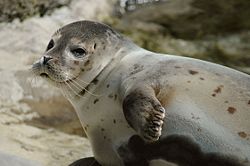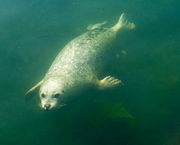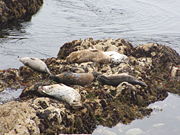Harbor Seal
| Harbor Seal | ||||||||||||||||
|---|---|---|---|---|---|---|---|---|---|---|---|---|---|---|---|---|
 |
||||||||||||||||
| Conservation status | ||||||||||||||||
|
Near Threatened (IUCN 2.3) |
||||||||||||||||
| Scientific classification | ||||||||||||||||
|
||||||||||||||||
| Binomial name | ||||||||||||||||
| Phoca vitulina Linnaeus, 1758 |
||||||||||||||||
Range of Phoca vitulina
|
The Harbor Seal (Phoca vitulina), also known as the Common Seal or alternately spelled Harbour Seal, is a true seal found along temperate and Arctic marine coastlines of the Northern hemisphere. They are found in coastal waters of the northern Atlantic and Pacific Oceans as well as those of the Baltic and North Seas, making them the most wide-ranging of the pinnipeds (walruses, eared seals, and true seals).
Harbor seals are brown, tan, or gray, with distinctive V-shaped nostrils. An adult can attain a length of 1.85 meters (6.1 ft) and a mass of 132 kilograms (290 lbs). Females outlive males (30-35 years versus 20-25 years). Harbor seals stick to familiar resting spots, generally rocky areas where land predators can't reach them, near a steady supply of fish to eat. Males fight over mates underwater. Females mate with the strongest males, then bear single pups, which they care for alone. Pups are able to swim and dive within hours of birth, and they grow quickly on their mothers' milk. A fatty tissue called "blubber" keeps them warm.
Their global population is 400,000 to 500,000, and subspecies in certain habitats are threatened. Seal hunting, once a common practice, is now mostly illegal.
Contents |
Description

With each individual possessing a unique pattern of fine, dark spots (or light spots on a dark background in some variants), they vary in colour from brownish black to tan or grey; underparts are generally lighter. The body and flippers are short, with a proportionately large, rounded head. The nostrils appear distinctively V-shaped; as with other true seals, there is no ear flap, or pinna. A relatively large (for a seal) ear canal may be visible behind the eye. Including the head and flippers, they may reach an adult length of 1.85 metres (6.1 ft) and a weight of 55 to 168 kg (120 to 370 lbs).[1] Females are generally smaller than males.
Population
With an estimated 400,000 to 500,000 individuals, the population is not threatened as a whole; most subspecies are secure in numbers with the Greenland, Hokkaidō and Baltic Sea populations being exceptions. Local populations have been reduced or eliminated through outbreaks of disease and conflict with humans, both unintentionally and intentionally. While it is legal to kill seals which are perceived to threaten fisheries in the United Kingdom, Norway and Canada, commercial hunting is illegal; the seals are also taken in subsistence hunting and accidentally as bycatch in fishing nets. In the United States stricter protection applies, and it is illegal to kill any seals or any marine mammals, as they fall under the Marine Mammal Protection Act. On the East Coast of the United States their numbers seem to be increasing quite steadily as they are reclaiming parts of their range, and have been seen as far south as South Carolina.
Female Harbor Seals have a life span of 30-35 years while male lifespans are usually 20-25. Scientists have suggested that this is due to stresses male seals are subjected to during breeding seasons.
Subspecies

There are four or five subspecies:
- Western Atlantic Harbor Seal Phoca vitulina concolor (DeKay, 1842). Eastern North America.
- Ungava Seal Phoca vitulina mellonae (Doutt, 1942). Eastern Canada, freshwater (included in P. v. concolor by many authors)
- Pacific Harbor Seal Phoca vitulina richardsi (Gray, 1864 - National Assoication For Biotechnology Information). Western North America.
- Insular Seal Phoca vitulina stejnegeri (Allen, 1902). Eastern Asia. This subspecies is sometimes treated as a separate species, Phoca kurilensis or Phoca insularis.
- Eastern Atlantic Common Seal Phoca vitulina vitulina (Linnaeus, 1758). Europe, western Asia. They are one of the most common seal in the world.
Habitat and diet

Characterized as showing a strong degree of site fidelity in their choice of resting sites, they may spend several days at sea and travel up to 50 kilometres in search of feeding grounds, and will also swim some distance upstream into freshwater in large rivers. Resting sites may be both rugged, rocky coasts such as that of the Hebrides or the shorelines of New England, or sandy beaches. They also inhabit sandy intertidal zones; some seals may also enter estuaries in pursuit of their fish prey. Some have even taken to feeding and playing in New York Harbor and Boston Harbor in recent years. The seals frequently choose to congregate in harbours, lending the animals their other common name. The feeding habits have been studied closely in many parts of their range; they are known to prey primarily upon fish such as menhaden, anchovy, sea bass, herring, cod, whiting and flatfish, and occasionally upon shrimp, mollusks and squid. They are able to dive for up to ten minutes, reaching depths of 457 metres (approx 1500 feet) or more, but average dives may be three minutes long at depths of about 20 metres (approx 66 feet) {Carl, 1964}.
Behavior and reproduction

While not forming groups as large as some other seals, they are gregarious animals. When not actively feeding, the seals will haul themselves out of the water and onto a preferred resting site. The seals tend to hug the coast, not venturing more than 20 kilometres offshore. Both courtship and mating occurs underwater. The mating system is not known, but thought to be polygamous. Females are thought to give birth once per year, with a gestation period of eleven months.
Birthing of pups occurs annually on shore, beginning in February for populations in lower latitudes, and as late as July in the subarctic zone. The mothers are the sole providers of care with lactation lasting four to six weeks; males occupy themselves with fights between other males. Researchers have found that males gather underwater, turn on their backs, put their heads together and vocalise to attract females ready for breeding. The pups are born singly and well developed, capable of swimming and diving within hours. Suckling for three to four weeks, pups feed on the mother's rich, fatty milk and grow rapidly; born weighing up to 16 kilograms, the pups may double their weight by the time of weaning.
Harbor Seals must spend a great deal of time on shore when moulting (shedding off their fur), which the seals undergo shortly after breeding. This onshore time is important to the life cycle and can be disturbed when there is substantial human presence (Sullivan, 1989). A female will mate again immediately following the weaning of her pup. This pinniped is sometimes reluctant to haul out in the presence of humans, so that shoreline development and access must be carefully studied in known locations of seal haul out.
Physical Characteristics
The physical characteristics of Harbor Seals include their size, body shape, and coloration. The size of male harbor seals can reach about 1.4 to 2 meters in length with a mass of 70 to 170 kilograms. The size of female harbor seals can reach about 1.2 to 1.7 meters in length with a mass of 50 to 150 kilograms. They have a rounded, spindle-shaped body. Coloration varies from light gray or silver to black or even brown. Spots or rings are visible on the dorsal surface and much more sparse on the underside.
Aspects particular to California

The California population of subspecies richardsi amounted to approximately 25,000 individuals as of the year 1984. Pacific harbor seals or Californian harbor seals are found along the entire Pacific coast shoreline of the state. They prefer to remain relatively close to shore in sub-tidal and intertidal zones, and have not been seen beyond the Channel Islands as a pelagic form; moreover, they will often venture into bays and estuaries and even swim up coastal rivers.
Frequently they will haul out in small to medium sized groups onto rock outcrops, mudflats, sandy beaches or even fishing piers. Some of the best locations for viewing Harbor Seals up close are at Children's Pool Beach in La Jolla, Cannery Row in Monterey, Moss Landing on Monterey Bay or at Bolinas Lagoon in Marin County. They feed in shallow littoral waters on herring, flounder, hake, anchovy, codfish and sculpin (Newby, 1978).
In California breeding occurs from March to May, and pupping between April and May depending on local populations. There is no indication this species has territorial characteristics in water, and it definitely displays none on land. As top level feeders in the kelp forest, Harbor Seals enhance species diversity and productivity. They are preyed upon by orcas and white sharks.
Considerable scientific inquiry has been carried out by The Marine Mammal Center and other research organizations beginning in the 1980s regarding the incidence and transmission of diseases in Harbor seals in the wild, including analysis of phocine herpesvirus (Goldstein, 2004). In the San Francisco Bay, some harbor seals are fully or partially reddish in color. This may be caused by an accumulation of trace elements such as iron or selenium in the ocean or a change in the hair follicle.
See also
- Conservation of Seals Act 1970 (in the UK)
- Wadden Sea Agreement (in the Netherlands, Germany and Denmark)
Notes
- ↑ Kindersley, Dorling (2001,2005). Animal. New York City: DK Publishing. ISBN 0-7894-7764-5.
References and external links
- IUCN Red List: Phoca vitulina
- Phoca vitulina (TSN 180649). Integrated Taxonomic Information System. Retrieved on 23 March 2006.
- ARKive - images and movies of the Harbor seal.
- SealWatch.org - photos of harbor seal haulouts from Alaska to the UK.
- van den Toorn, jaap (1999-09-21). "Harbor seals". Jaap's Marine Mammal Pages. Retrieved on 2006-06-26.
- California Wildlife, Volume III, Mammals, ed, by David C. Zeiner, William F. Laudenslayer and Kenneth E. Meyer, published by the California Department of Fish and Game, Apr. , 1990.
- CRC Handbook of Marine Mammal Medicine, edited by Leslie A Dierauf, Frances M D Gulland,, CRC Press (2001) ISBN 0-8493-0839-9
- Joan Hewitt, A Harbor Seal Pup Grows Up, Carolrhoda Books (2002) ISBN 1-57505-166-4
- Patrick Sullivan, Gary Deghi and C.Michael Hogan, Harbor Seal Study for Strawberry Spit, Marin County, California, Earth Metrics file reference 10323, BCDC and County of Marin, January 23, 1989
- T.C. Newby, Pacific Harbor Seal, pp 184-191 in D. Haley, ed. Marine Mammals of Eastern North Pacific and Arctic Waters, Pacific Search Press, Seattle WA (1978)
- Goldstein, T., Mazet, J.A.K., Gulland, F.M.D., Rowles, T., Harvey, J.T., Allen, S.G., King, D.P., Aldridge, B.M., Stott, J.L., "The transmission of phocine herpesvirus-1 in rehabilitating and free-ranging Pacific harbor seals (Phoca vitulina) in California", Veterinary Microbiology 103:131-141 (2004)
- Marine Mammal Center - Harbor Seal
|
|||||||||||||||||||||||||||||||||||||||||||||||
